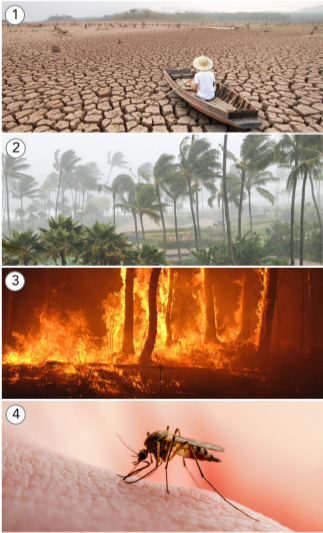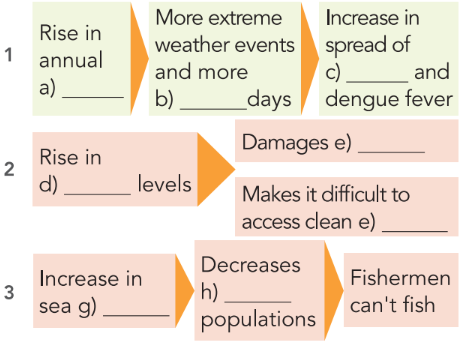Tiếng Anh 11 Unit 3 3.3 Listening1. Look at the photos. What is happening in each photo? Then match the words given with each photo. 2. Listen to a news report about global warming in the Philippines. Tick (✔) the ideas that have been mentioned in the report. 3. Listen again and complete the diagram with the words from the report. 4. Listen again. Choose the correct answer for each sentence. 5. In groups, choose one cause of global warming and discuss its effects. You can use the diagram in Exercise 3 to help you.
Lựa chọn câu để xem lời giải nhanh hơn
Bài 1 1. Look at the photos. What is happening in each photo? Then match the words given with each photo. (Nhìn vào những bức ảnh. Điều gì đang xảy ra trong mỗi bức ảnh? Sau đó nối các từ đã cho với mỗi bức ảnh.) a. forest fire (cháy rừng) b. drought (hạn hán) c. malaria (bệnh sốt rét) d. typhoon (bão nhiệt đới)
Lời giải chi tiết:
Lời giải chi tiết: Đang cập nhật! Bài 2 2. Listen to a news report about global warming in the Philippines. Tick (✔) the ideas that have been mentioned in the report. (Nghe một bản tin về sự nóng lên toàn cầu ở Philippines. Đánh dấu (✔) vào các ý đã được đề cập trong báo cáo.) 1. Annual temperatures have risen. (Nhiệt độ hàng năm đã tăng lên.) 2. There is less rainfall nowadays. (Hiện nay lượng mưa ít hơn.) 3. Increased rain and typhoons are causing problems in the Philippines. (Mưa và bão gia tăng đang gây ra nhiều vấn đề ở Philippines.) 4. Some diseases are spreading as a result to more rainfall. (Một số dịch bệnh đang lan rộng do lượng mưa nhiều hơn.) 5. Sea levels are starting to decrease in the past few years. (Mực nước biển bắt đầu giảm trong vài năm qua.) 6. Sea temperatures are also increasing. (Nhiệt độ nước biển cũng đang tăng lên.) Phương pháp giải: Bài nghe: I'm sure you have heard about global warming and its negative effects on our planet. You're probably wondering how it happens. In today's report, I'll share with you some findings from scientists in the Philippines. Annual temperatures in the Philippines have risen by 0.6°C between 1958-2014. The result is there has been an increase in the amount of extreme weather events, such as typhoons, and overall rainfall. In recent years, the Philippines has experienced more rainy days than in previous decades. This has led to a variety of problems. The number of people affected by diseases spread by mosquitoes, such as malaria and dengue fever, are increasing. This is the direct result of more rainwater which helps increase mosquito populations. Sea levels are rising twice the global average and are affecting people living in coastal areas. This is affecting 14% of the total population, damaging roads, and making it difficult for people to access clean water. Some coastal communities may soon be underwater. At the same time, there have been increases in sea temperatures. These warmer waters are harming fish populations. Today fishermen are having more difficulty catching enough fish to feed their families. I'm sure you're eager to make sure our country is not going to have similar problems, so we need to act fast to prevent global warming. Tạm dịch: Tôi chắc rằng bạn đã nghe nói về hiện tượng nóng lên toàn cầu và những tác động tiêu cực của nó đối với hành tinh của chúng ta. Có lẽ bạn đang tự hỏi làm thế nào nó xảy ra. Trong bản tin ngày hôm nay, tôi sẽ chia sẻ với các bạn một số phát hiện từ các nhà khoa học ở Philippines. Nhiệt độ hàng năm ở Philippines đã tăng 0,6°C trong giai đoạn 1958-2014. Kết quả là lượng các hiện tượng thời tiết cực đoan như bão và lượng mưa nói chung đã gia tăng. Những năm gần đây, Philippines trải qua nhiều ngày mưa hơn những thập kỷ trước. Điều này đã dẫn đến nhiều vấn đề khác nhau. Số người bị ảnh hưởng bởi các bệnh lây truyền qua muỗi, như sốt rét và sốt xuất huyết, ngày càng gia tăng. Đây là kết quả trực tiếp của việc có nhiều nước mưa giúp tăng số lượng muỗi. Mực nước biển đang tăng gấp đôi mức trung bình toàn cầu và đang ảnh hưởng đến người dân sống ở khu vực ven biển. Điều này đang ảnh hưởng đến 14% tổng dân số, làm hư hại đường sá và khiến người dân khó tiếp cận được nước sạch. Một số cộng đồng ven biển có thể sớm chìm dưới nước. Đồng thời, nhiệt độ nước biển đã tăng lên. Những vùng nước ấm hơn này đang gây hại cho quần thể cá. Ngày nay ngư dân gặp nhiều khó khăn hơn trong việc đánh bắt đủ cá để nuôi sống gia đình. Tôi chắc rằng bạn rất mong muốn đảm bảo rằng đất nước chúng ta sẽ không gặp phải những vấn đề tương tự, vì vậy chúng ta cần hành động nhanh chóng để ngăn chặn hiện tượng nóng lên toàn cầu. Lời giải chi tiết: The mentioned ideas: 1, 3, 4, 6 (Những ý được nhắc đến: 1, 3, 4, 6) Lời giải chi tiết: Đang cập nhật! Bài 3 3. Listen again and complete the diagram with the words from the report. (Nghe lại và hoàn thành sơ đồ với các từ trong báo cáo.)
Phương pháp giải: Bài nghe: I'm sure you have heard about global warming and its negative effects on our planet. You're probably wondering how it happens. In today's report, I'll share with you some findings from scientists in the Philippines. Annual temperatures in the Philippines have risen by 0.6°C between 1958-2014. The result is there has been an increase in the amount of extreme weather events, such as typhoons, and overall rainfall. In recent years, the Philippines has experienced more rainy days than in previous decades. This has led to a variety of problems. The number of people affected by diseases spread by mosquitoes, such as malaria and dengue fever, are increasing. This is the direct result of more rainwater which helps increase mosquito populations. Sea levels are rising twice the global average and are affecting people living in coastal areas. This is affecting 14% of the total population, damaging roads, and making it difficult for people to access clean water. Some coastal communities may soon be underwater. At the same time, there have been increases in sea temperatures. These warmer waters are harming fish populations. Today fishermen are having more difficulty catching enough fish to feed their families. I'm sure you're eager to make sure our country is not going to have similar problems, so we need to act fast to prevent global warming. Tạm dịch: Tôi chắc rằng bạn đã nghe nói về hiện tượng nóng lên toàn cầu và những tác động tiêu cực của nó đối với hành tinh của chúng ta. Có lẽ bạn đang tự hỏi làm thế nào nó xảy ra. Trong bản tin ngày hôm nay, tôi sẽ chia sẻ với các bạn một số phát hiện từ các nhà khoa học ở Philippines. Nhiệt độ hàng năm ở Philippines đã tăng 0,6°C trong giai đoạn 1958-2014. Kết quả là lượng các hiện tượng thời tiết cực đoan như bão và lượng mưa nói chung đã gia tăng. Những năm gần đây, Philippines trải qua nhiều ngày mưa hơn những thập kỷ trước. Điều này đã dẫn đến nhiều vấn đề khác nhau. Số người bị ảnh hưởng bởi các bệnh lây truyền qua muỗi, như sốt rét và sốt xuất huyết, ngày càng gia tăng. Đây là kết quả trực tiếp của việc có nhiều nước mưa giúp tăng số lượng muỗi. Mực nước biển đang tăng gấp đôi mức trung bình toàn cầu và đang ảnh hưởng đến người dân sống ở khu vực ven biển. Điều này đang ảnh hưởng đến 14% tổng dân số, làm hư hại đường sá và khiến người dân khó tiếp cận được nước sạch. Một số cộng đồng ven biển có thể sớm chìm dưới nước. Đồng thời, nhiệt độ nước biển đã tăng lên. Những vùng nước ấm hơn này đang gây hại cho quần thể cá. Ngày nay ngư dân gặp nhiều khó khăn hơn trong việc đánh bắt đủ cá để nuôi sống gia đình. Tôi chắc rằng bạn rất mong muốn đảm bảo rằng đất nước chúng ta sẽ không gặp phải những vấn đề tương tự, vì vậy chúng ta cần hành động nhanh chóng để ngăn chặn hiện tượng nóng lên toàn cầu. Lời giải chi tiết:
1. Rise in annual temperatures > More extreme weather events and more rainy days > Increase in spread of malaria and dengue fever (Nhiệt độ hằng năm tăng > Xảy ra nhiều hiện tượng thời tiết cực đoan và nhiều ngày mưa hơn > Làm gia tăng sự lây truyền của bênh sốt rét và sốt xuất huyết) 2. Rise in sea levels > Damages roads, Make it difficult to acccess the clean water (Mực nước biển dâng > Làm hư hại đường xá, Khó tiếp cận với nguồn nước sạch) 3. Increase in sea temperatures > Decreases fish populations > Fishermen can't fish (Nhiệt độ nước biển tăng > Giảm lượng cá > Ngư dân không thể đánh bắt) Lời giải chi tiết: Đang cập nhật! Bài 4 4. Listen again. Choose the correct answer for each sentence. (Lắng nghe một lần nữa. Chọn câu trả lời đúng cho mỗi câu.) 1. What does global warming cause in the Philippines? (Sự nóng lên toàn cầu gây ra điều gì ở Philippines?) a. extreme weather events (những sự kiện thời tiết cực đoan) b. an increase in fish populations (sự gia tăng quần thể cá) 2. What is the result of increases in temperatures and more severe weather events? (Hậu quả của việc tăng nhiệt độ và các hiện tượng thời tiết khắc nghiệt hơn là gì?) a. the destruction of coastal areas (sự phá hủy các khu vực ven biển) b. global warming (sự nóng lên toàn cầu) 3. What leads to the decrease in fish populations? (Điều gì dẫn đến sự suy giảm quần thể cá?) a. an increase in sea temperatures (sự gia tăng nhiệt độ nước biển) b. an increase in the number of droughts (sự gia tăng số lần hạn hán) 4. What has made the Philippines warmer? (Điều gì đã làm cho Philippines ấm hơn?) a. increasing population (dân số ngày càng tăng) b. rises in annual temperatures (tăng nhiệt độ hàng năm) 5. What do mosquitoes spread? (Muỗi truyền bệnh gì?) a. forest fires (cháy rừng) b. dengue fever (sốt xuất huyết) Phương pháp giải: Bài nghe: I'm sure you have heard about global warming and its negative effects on our planet. You're probably wondering how it happens. In today's report, I'll share with you some findings from scientists in the Philippines. Annual temperatures in the Philippines have risen by 0.6°C between 1958-2014. The result is there has been an increase in the amount of extreme weather events, such as typhoons, and overall rainfall. In recent years, the Philippines has experienced more rainy days than in previous decades. This has led to a variety of problems. The number of people affected by diseases spread by mosquitoes, such as malaria and dengue fever, are increasing. This is the direct result of more rainwater which helps increase mosquito populations. Sea levels are rising twice the global average and are affecting people living in coastal areas. This is affecting 14% of the total population, damaging roads, and making it difficult for people to access clean water. Some coastal communities may soon be underwater. At the same time, there have been increases in sea temperatures. These warmer waters are harming fish populations. Today fishermen are having more difficulty catching enough fish to feed their families. I'm sure you're eager to make sure our country is not going to have similar problems, so we need to act fast to prevent global warming. Tạm dịch: Tôi chắc rằng bạn đã nghe nói về hiện tượng nóng lên toàn cầu và những tác động tiêu cực của nó đối với hành tinh của chúng ta. Có lẽ bạn đang tự hỏi làm thế nào nó xảy ra. Trong bản tin ngày hôm nay, tôi sẽ chia sẻ với các bạn một số phát hiện từ các nhà khoa học ở Philippines. Nhiệt độ hàng năm ở Philippines đã tăng 0,6°C trong giai đoạn 1958-2014. Kết quả là lượng các hiện tượng thời tiết cực đoan như bão và lượng mưa nói chung đã gia tăng. Những năm gần đây, Philippines trải qua nhiều ngày mưa hơn những thập kỷ trước. Điều này đã dẫn đến nhiều vấn đề khác nhau. Số người bị ảnh hưởng bởi các bệnh lây truyền qua muỗi, như sốt rét và sốt xuất huyết, ngày càng gia tăng. Đây là kết quả trực tiếp của việc có nhiều nước mưa giúp tăng số lượng muỗi. Mực nước biển đang tăng gấp đôi mức trung bình toàn cầu và đang ảnh hưởng đến người dân sống ở khu vực ven biển. Điều này đang ảnh hưởng đến 14% tổng dân số, làm hư hại đường sá và khiến người dân khó tiếp cận được nước sạch. Một số cộng đồng ven biển có thể sớm chìm dưới nước. Đồng thời, nhiệt độ nước biển đã tăng lên. Những vùng nước ấm hơn này đang gây hại cho quần thể cá. Ngày nay ngư dân gặp nhiều khó khăn hơn trong việc đánh bắt đủ cá để nuôi sống gia đình. Tôi chắc rằng bạn rất mong muốn đảm bảo rằng đất nước chúng ta sẽ không gặp phải những vấn đề tương tự, vì vậy chúng ta cần hành động nhanh chóng để ngăn chặn hiện tượng nóng lên toàn cầu. Lời giải chi tiết:
1. What does global warming cause in the Philippines? (Sự nóng lên toàn cầu gây ra điều gì ở Philippines?) => a. extreme weather events (những sự kiện thời tiết cực đoạn) Thông tin: Annual temperatures in the Philippines have risen by 0.6°C between 1958-2014. The result is there has been an increase in the amount of extreme weather events, such as typhoons, and overall rainfall. (Nhiệt độ hàng năm ở Philippines đã tăng 0,6°C trong giai đoạn 1958-2014. Kết quả là lượng các hiện tượng thời tiết cực đoan như bão và lượng mưa nói chung đã gia tăng.) 2. What is the result of increases in temperatures and more severe weather events? (Hậu quả của việc tăng nhiệt độ và các hiện tượng thời tiết khắc nghiệt hơn là gì?) => b. global warming (sự nóng lên toàn cầu) Thông tin: I'm sure you have heard about global warming and its negative effects on our planet. You're probably wondering how it happens. In today's report, I'll share with you some findings from scientists in the Philippines. Annual temperatures in the Philippines have risen by 0.6°C between 1958-2014. The result is there has been an increase in the amount of extreme weather events, such as typhoons, and overall rainfall. (Tôi chắc rằng bạn đã nghe nói về hiện tượng nóng lên toàn cầu và những tác động tiêu cực của nó đối với hành tinh của chúng ta. Có lẽ bạn đang tự hỏi làm thế nào nó xảy ra. Trong bản tin ngày hôm nay, tôi sẽ chia sẻ với các bạn một số phát hiện từ các nhà khoa học ở Philippines. Nhiệt độ hàng năm ở Philippines đã tăng 0,6°C trong giai đoạn 1958-2014. Kết quả là lượng các hiện tượng thời tiết cực đoan như bão và lượng mưa nói chung đã gia tăng.) 3. What leads to the decrease in fish populations? (Điều gì dẫn đến sự suy giảm quần thể cá?) => a. an increase in sea temperatures (sự gia tăng nhiệt độ nước biển) Thông tin: These warmer waters are harming fish populations. (Những vùng nước ấm hơn này sẽ làm hại đến những quần thể cá.) 4. What has made the Philippines warmer? (Điều gì đã làm cho Philippines ấm hơn?) => b. rises in annual temperatures (sự tăng nhiệt độ hàng năm) Thông tin: Annual temperatures in the Philippines have risen by 0.6°C between 1958-2014. (Nhiệt độ hằng năm ở Phi-lip-pin đã tăng 0.6°C từ 1958 đến 2014.) 5. What do mosquitoes spread? (Muỗi truyền bệnh gì?) => b. dengue fever (sốt xuất huyết) Thông tin: The number of people affected by diseases spread by mosquitoes, such as malaria and dengue fever, are increasing. (Số người bị ảnh hưởng vởi những bệnh lây lan bởi muỗi, như sốt rét và sốt xuất huyết đang tăng lên.) Bài 5 5. In groups, choose one cause of global warming and discuss its effects. You can use the diagram in Exercise 3 to help you. (Theo nhóm, chọn một nguyên nhân gây ra sự nóng lên toàn cầu và thảo luận về tác động của nó. Bạn có thể sử dụng sơ đồ trong Bài tập 3 để giúp bạn.) Lời giải chi tiết: Cutting down forests is one of the main causes of global warming. This action reduces oxygen levels, adds huge amounts of greenhouse gases in the atmosphere because we have no trees to absorb carbon dioxide. Deforestation also causes drought. In regions where trees have been cut down, there is less moisture in the air because trees help to manage the amount of water in the atmosphere. Tạm dịch: Chặt phá rừng là một trong những nguyên nhân chính của sự nóng lên toàn cầu. Hành động này làm giảm nồng độ oxy, bổ sung một lượng lớn khí nhà kính trong bầu khí quyển vì chúng ta không có cây xanh để hấp thụ carbon dioxide. Phá rừng cũng gây hạn hán. Ở những vùng cây cối bị đốn hạ, độ ẩm trong không khí ít hơn vì cây cối giúp quản lý lượng nước trong khí quyển. Bài 6 PRONUNCIATION FOCUS: CONTRACTION (PHÁT ÂM TRỌNG TÂM: RÚT GỌN) 6. Listen and circle the form you hear for each sentence. (Nghe và khoanh tròn dạng bạn nghe được cho mỗi câu.)
Phương pháp giải: Bài nghe: 1 We'll work hard to prevent global warming from getting worse. (Chúng tôi sẽ làm việc chăm chỉ để ngăn chặn tình trạng nóng lên toàn cầu trở nên tệ hơn.) 2 She is concerned that the coastal communities might get flooded. (Cô ấy đang lo lắng về những cộng đồng ven biển có thể gặp lũ lụt.) 3 We're seeing more cases of malaria every year. (Chúng tôi đang gặp ngày càng nhiều ca nhiễm sốt rét qua từng năm.) 4 I'm not so sure that we're doing enough to prevent global warming. (Tôi không chắc việc chúng ta đang làm là đủ để ngăn chặn nóng lên toàn cầu.) 5 They're worried about the rises in sea levels. (Họ đang lo lắng về mực nước biển tăng.)
>> 2K9 Học trực tuyến - Định hướng luyện thi TN THPT, ĐGNL, ĐGTD ngay từ lớp 11 (Xem ngay) cùng thầy cô giáo giỏi trên Tuyensinh247.com. Bứt phá điểm 9,10 chỉ sau 3 tháng, tiếp cận sớm các kì thi.
|























